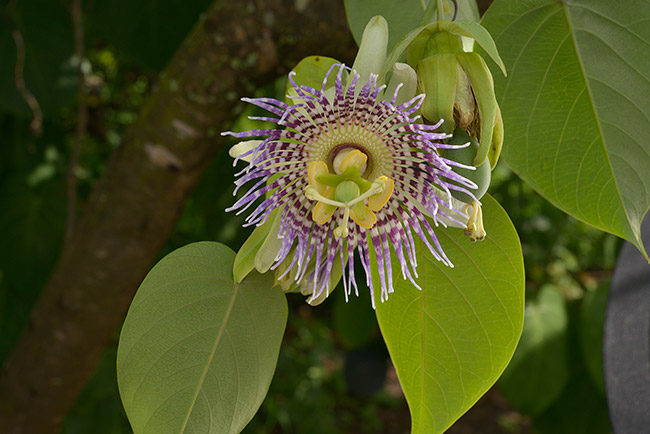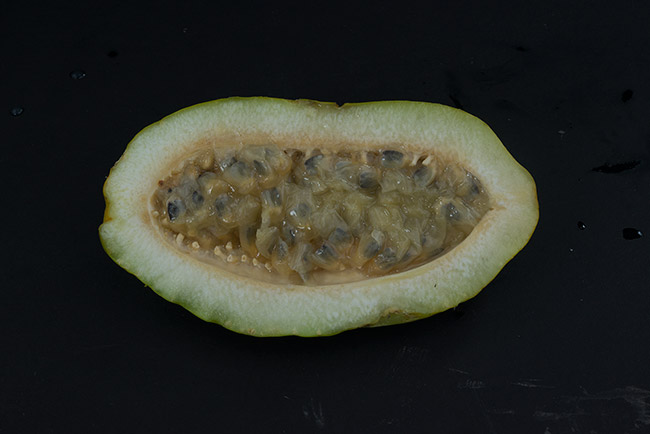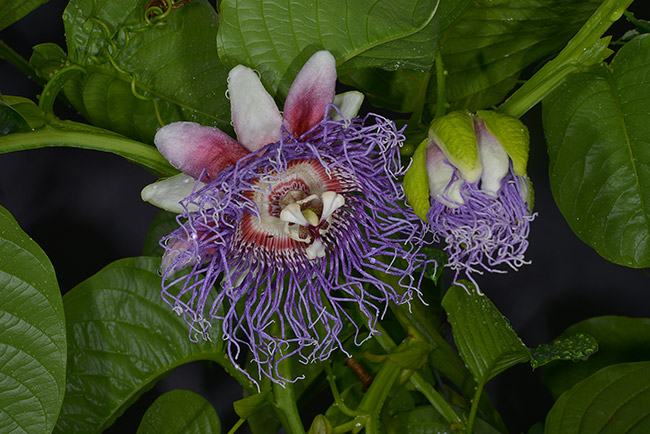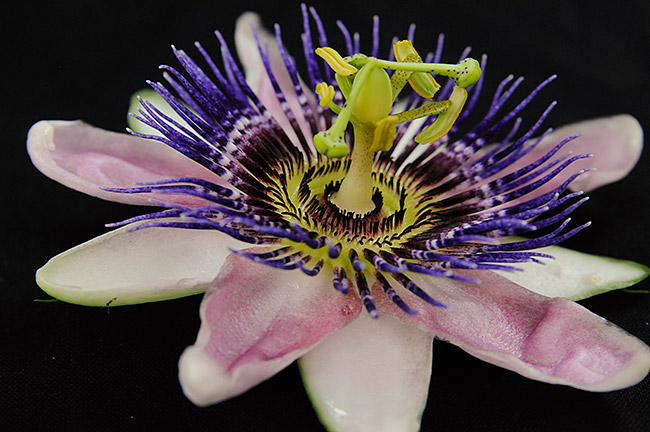Common names in Mesoamerica for Passiflora quadrangularis
In Guatemala it is known as maracuja or maracuyá. In other countries as badea. It is typical for fruits in Latin America to have a slightly different name in different countries. Often in one country there may be a different name depending on what part of the country, and depending on whether you are speaking with a botanist or a local Mayan farmer.
Agronomist Mauro Gulielmo García says the Q’eqchi’ word for this fruit is C’um Bat’z. He lives in Coban, Alta Verapaz, Guatemala, and knows this Passiflora and its fruit well.
The Vine and Fruit of Passiflora quadrangularis
The vine produced flowers and fruits about the level of the second floor of a two storey house (and this was because the tree the vine was on was only this height). In other words, I bet the vine would grow much higher if we had taller trees.
The fruit falls when it is very mature (so the fruit usually smashes a bit when it hits the ground. If you wish to eat it, I suggest harvesting it a day or so before it is soft enough to fall of its own weight.
Our ethnobotanical garden surrounding our offices have so many species of plants that until a budget is available it is not realistic to note down and keep track of which each plant flowers. But the fruit was harvested in late August 2014. It had been many months since the vine had flowered.
Our two other (non-native) species of passionflower vine flower almost all year round. One of our passionflower vines produces fruit many months out of the year. This keeps the local squirrels very happy.
Not many people in our office like to eat the fruits, though fruits of some species are sold in the markets of the Quiche region of Chichicastenango. The fruit of Passiflora quadrangularis is edible, but seemingly not very popular (at least not among the 15 people in our office).But agricultural specialist from Alta Verapaz, Mauro Garcia, says Passiflora quadrangularis is both edible and tasty.
Growing Conditions for Passiflora quadrangularis in Guatemala
Julia Morton suggests: “The ideal climate for the giant granadilla is one that is truly tropical, warm both day and night, with little fluctuation, and with high humidity.”
1987. Giant Granadilla. p. 328–330. In: Fruits of warm climates. Julia F. Morton, Miami, FL.
But Highland Guatemala (1500 meters elevation where the FLAAR Mayan ethnobotanical garden is located) has a long dry period. Plus, it gets cool every single night. I sleep under goose down European style covers all year long even in July and August!
So I suggest the habitat description can be more flexible. Our Passiflora quadrangularis is very content, flowers much of the year, and produces large fruits. Presently it is mid-July and it has been flowering for several weeks. Previously it was so high in a tree that I never noticed when it flowered, but high winds blew the tree down and our Q’eqchi’ Mayan gardener skillfully rescued most of the vines.
Rats or Mice ate most of the Passiflora quadrangularis seeds
We were about to plant more of the seeds, but when we went to get them (where they are stored in the garage), something had eaten them all. The gardener estimated it was rats or mice, though there are also opossums wandering through the garden every night. The gardener prefers to let the seeds dry totally before he plants them (so this gave time for the rodents to eat them).
We have four species of Passiflora growing in our garden
A red-flowered Passiflora has gorgeous flowers most of the year. But so far I have not seen any fruit: never, ever (yet two other species produce fruit constantly). This red-flowered Passiflora plant is not native to Guatemala but is common due to the beautiful flowers.
A lavender-flowered Passiflora has many fruits. The squirrels like these fruits but no one in the office eats them. Passiflora quadrangularis fruits several times a year; you can tell they are from Passiflora quadrangularis since the fruits are very large. Recently a fourth fruit appeared. They look like a tiny watermelon (except are hanging from a vine over my doorway). Since we have so many plants creating a veritable jungle around my house, I have no way to know what species or even for sure whether it is a passiflora vine (though I estimate it is).
Potential medicinal uses of Passiflora quadrangularis
We are interested in Passiflora quadrangularis because it has medicinal use, plus at least one species of passionflower is a flavoring for cacao drink (or the cacao is used as a vehicle to ingest the chemicals of the Passiflora species).
Our bibliography on Passiflora quadrangularis is on our bibliography web site, www.maya-art-books.org
We thank botanist John MacDougal, Harris-Stowe State University in Missouri, for providing information and documentation on the passionflower plants of Mesoamerica. We share our information with him (and with Armando Caceres, in other words, we share our findings with scholars who help our learning curve).
We appreciate the help of ethnobotanist Armando Caceres in finding various native species of Passiflora in Guatemala. We also appreciate the work of our ethnobotanical team, plant scouts, and photographer Sofia Monzon plus new photographer on the FLAAR team, her cousin Melanny Celeste Quiñonez Izquierdo.
Visit our other site on Passiflora.
Most recently updated July 20, 2015
after seeing how many of our Passiflora vines were flowering and fruiting (but still not a single fruit on the red-flowered species).
Previously updated November 6, 2014.
First posted August 2014, after harvesting several fruit pods in our own garden.

















































































